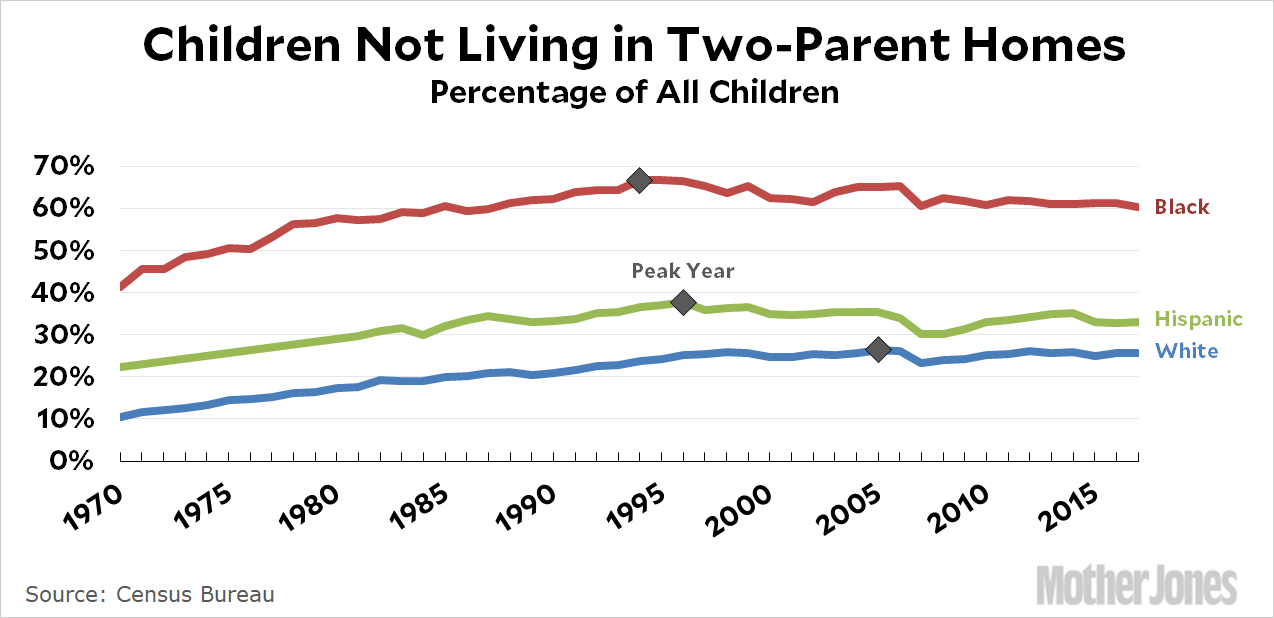A few days ago Matt Yglesias wrote about whether family structure matters. He points to recent research that confirms the common belief that it does:
Poor kids have a better chance of being upwardly mobile if they grow up in a low-poverty neighborhood. They have a worse chance of being upwardly mobile if they grow up in a racially segregated environment with no white people around. And they have a better chance of being upwardly mobile — regardless of their own family situation — if they grow up in a neighborhood with a lot of two-parent households….It’s an interesting finding. David Leonhardt chides liberals for being reluctant to talk about it. I’m not totally averse to talking about it (after all, I am talking about it now) but I’m not really sure there’s a lot to be said about it.
Yglesias’s point is one that I’ve long agreed with. For various reasons—and research generally backs up this intuition—it seems pretty obvious that a two-parent family is better for everyone. Boys and girls both have role models close at hand. Household income is probably higher. There are two people to take care of the kids instead of just one. Family life is less stressful with two adults in the house. Etc. What’s more, highly educated liberals all endorse this view in the most convincing way possible: by overwhelmingly choosing to raise their own kids in traditional married households.
Still, even if we agree about this, what exactly can we do to promote it? That’s a real poser, and it first requires us to figure out what caused the rise of single-parent homes in the first place. There are some hints in this chart:

There are two takeaways from this:
- Two-parent homes are making a comeback. The share of children raised in one-parent homes peaked between 1995-2005 and has either flattened or declined ever since.
- Single-parent homes are most predominant among African-Americans, but have also increased by more than 2x among white families.
I said this chart contained some hints about what led to the rise of single-parent homes, and here they are:
- Up through the 90s, it was common to blame the whole thing on some unspecified rot in black culture. But that’s no longer tenable. Both Hispanics and whites have seen large increases in single-parent households too.
- Among all ethnic groups, the rise of single-parent homes peaked long ago. Whatever the original cause, it seems to have lost its power over the past couple of decades.
- Is rising poverty a contributing factor? No. Over the past 50 years or so, we’ve seen single-parent homes increase, peak, and decrease—and poverty hasn’t changed much the entire time. In fact, if you count non-cash welfare payments, poverty has decreased considerably.
- How about welfare dependency? I doubt it. Means-tested welfare as we know it didn’t really get started until 1965, and about a third of black children were already being raised in single-parent households by then. And if this is part of the reason, why the decline starting in the late 90s? Welfare reform may have had a substantial effect on cash welfare, but overall welfare spending per household continued its steady climb through the 90s all the way to the present day.
- Maybe the rise of feminism made women more choosy about their partners and they simply decided not to waste time with deadbeat husbands who were a net burden on their family? This is a fairly popular explanation, and one that I find at least a little bit plausible.
I’m not trying to cover everything here, just a few highlights. Generally speaking, I’m pretty strongly in favor of promoting two-parent households as a cultural norm—not for any moral reason, but because I think it’s better for everyone, both parents and kids. The problem is that I’ve never believed in the conservative idea that targeted programs like, say, a higher child tax credit will have any effect at all. Nor do I buy the liberal idea that we can just buy our way out of this problem with more generous welfare programs and better schools. Nor do I want to hear anything about Iceland.
I’ve just never been able to figure out what, if anything, we can do about this. And that’s largely because I can’t figure out what caused it in the first place.














